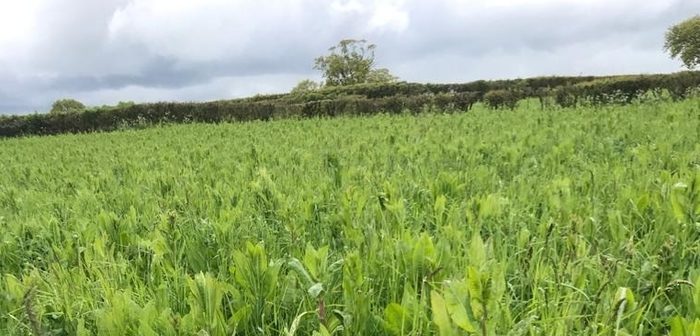Do what is right for your farm situation when considering the options available under the new Sustainable Farming Incentive (SFI).
That was the clear message to more than 150 growers at a recent open day at Warboys in Cambridgeshire, organised by the Hutchinsons Environmental Services team. The event, kindly hosted by the 180 ha P F England & Son family farm, examined some of the latest opportunities within the SFI, and how to select those that deliver the greatest benefits to individual farm businesses.
“There are many SFI options that can help mitigate the loss of BPS, but you have to do what’s right for your farm and not just chase the payments on offer,” environmental services specialist, Matt Powell said.

Matt Powell advised growers to do what’s right for your farm and not just chase the payments on offer
“Approach the SFI by keeping it simple at the start and build things up gradually. Begin by looking at what you are doing on the farm already, and then identify where it might be possible to integrate options that align with the aims of the business, whether that’s soil health, the environment, or crop productivity.
“Be clear about what you’re doing it for, and what you want from it, rather than simply doing the bare minimum to ‘tick a box’ that will get you the most money.”
There could be some “easy wins” though, especially where SFI options covered things that farmers were, or should be, doing already, he suggested. “Red Tractor standards, for example, require an Integrated Pest Management Plan to be in place, and the SFI offers £989 per year towards this. Likewise, for farmers already assessing soils on a regular basis and doing a soil management plan, there’s £5.80/ha, plus £95 per agreement, available towards that.”
He acknowledged the soils payment had been reduced from previous rates, but insisted it was still worth doing, especially as understanding soils was so fundamental to growing productive crops.
“Don’t forget, payments are often designed to subsidise the cost of doing various options, rather than being set at a level where it’s a money-making exercise.”
While some payments would go towards things that farmers were doing already, other options could be used as a catalyst for change, to deliver wider benefits for soil health, the environment, or crop yields. Careful thought was needed though, in order to select options that maximised those wider benefits.
Weighing up the options
Cover crops were a prime example of why it was important to target measures to individual situations, Mr Powell continued.
Multi-species winter cover crops were likely to be a popular SFI option among arable farmers, that attracted an annual payment of £129/ha under the 2023 scheme. However, with so many different eligible mixes available, care had to be taken when deciding which to choose.
“If you’ve not grown cover crops before, it’s worth trying a small area first, and maybe experiment with two or three different mixes to see what works in your soils and growing conditions. Multi-species mixes are best, because if you compromise on the number of species, there is a greater risk that you don’t achieve the cover required if there are problems during establishment.”
Hutchinsons technical manager, Dick Neale urged anyone considering SFI cover crop options to be clear about what they wanted them to achieve, and the particular growing conditions involved, before deciding on the most appropriate species mix and management approach.
Leguminous plants, for example, often struggled to perform straightaway on soils that had not grown legumes for a number of years, due to the lack of rhizospheric bacteria needed for nitrogen fixing symbiosis in the soil, he noted. This had been seen at the Warboys site, which featured trials of several cover mixes eligible for SFI options, such as the Legume fallow, worth £593/ha. In such cases it was better to introduce legumes slowly to let bacteria populations build, rather than going all-in with a legume-based option that may then struggle to establish, potentially jeopardising the payment.
There were also key differences within individual plant species that were important to recognise, he added. Mustard, which was in many cover crop mixes, was just one example.
“Both brown and white mustard are brassicas, but while brown mustard produces softer stems that generally snap easily when you are drilling into the cover, white mustard produces more lignified, upright stems that can be problematic if it’s not managed correctly. Nutrients in brown mustard may also be released more readily than in white mustard due to the latter taking longer to breakdown. Both have a place, but must be used appropriately.”
Fodder and tillage radishes were another example. Both produced a “punchy” tap root that could penetrate the soil profile, but tillage radish generally had a shorter growth habit than the tall stems of fodder radish, which could pose issues for those looking to direct drill into cover with a tined machine, he said.
“Again, these examples highlight the importance of taking your time to get any SFI option right, rather than just doing the minimum to chase the money available,” Mr Neale concluded.
Quantifying cover crop benefits
The annual payment available via the SFI is just one of many wider benefits that cover crops can offer, to soil health, nutrition and following crops. Quantifying these is challenging, however the Hutchinsons cover crop assessment service, can give a valuable insight.
Analysis of a MaxiCatchCrop mix grown at the Warboys site found that it had put on 22.8 t/ha of freshweight in a 6-8 week period between the end of July and September, equivalent to 5 t/ha dry weight. That contained 1.6 t/ha of carbon, equivalent to around 20 t/ha of farmyard manure, Mr Neale said.
“It just shows, that even with a relatively short-lived catch crop, it is possible for an arable farm without livestock to grow large amounts of its own carbon, which is so crucial to feeding healthy soils.”
The analysis also revealed that the cover contained 143 kg/ha of nitrogen, 115 kg/ha potassium and 15 kg/ha phosphate.
“Yes, the plants have taken a lot of that nutrition out of the soil, but it’s not being lost. It’s surprising how quickly that material will breakdown and release nutrients back into the soil, providing you’ve chosen the right mix and manage it correctly from sowing through to termination.
“The economic value of cover and catch crops can be significant, but it’s difficult to demonstrate, so if you’re growing a cover crop, it’s worth getting it assessed to see what the cover is delivering.”




